In recent years, with the use of computers and mobile phones growing day by day, eye twitches and ocular spasms have become more common. If left untreated, the condition can spread from the eyes to the facial muscles, seriously impacting the patient’s work and daily life.
Eye twitches usually begin in adulthood, but the causes are not well understood. Current treatments include drug therapies, botulinum injections, and surgical intervention, but these treat only the symptoms without addressing the underlying condition. Drugs prescribed in western countries sometimes have negative side effects and are expensive. By easing the tension in the eye muscles and relieving the stress that often brings on eye spasms, acupuncture may provide an effective treatment without adverse reactions.
What Is Eye Twitching?
Blepharospasm is a neurological disorder that causes an abnormal contraction of the eyelid muscles. The condition begins with twitching but can lead to episodic and involuntary closing of the eyelids, leaving patients unable to open their eyes.
Ocular Muscle Spasm (OMS) is an involuntary twitching or beating of the eye muscles. Patients may experience twitches in the upper or lower eyelids in one or both eyes.
What Causes Eye Twitching?
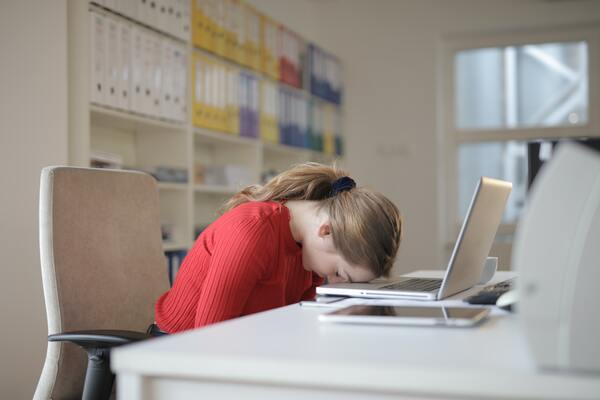
Though the exact causes remain unknown, risk factors include head or facial trauma, stress, medications (such as those used to treat Parkinson’s Disease), the use of substances such as caffeine and alcohol, insomnia or sleeplessness, and dry eyes.
Acupressure massage is a powerful stress reliever and can also help to improve sleep. Acupressure for twitching eyes increases blood flow to the eyes and stimulates and strengthens the muscles. Eye exercises, such as blinking and squeezing, help to lubricate and cleanse the eyeballs, relieving twitches caused by dry eyes.
Can Acupuncture Help With Twitching?
Acupuncture for eye twitching may help to ease tension in the muscles around the eyes and balance the autonomic nervous system. As a result, acupuncture improves the functioning of the parasympathetic nerves, relieves the stress and fatigue that causes eye spasms, and helps patients to relax and sleep better.
According to Traditional Chinese Medicine (TCM), acupuncture and moxibustion treatments activate the meridians, promote blood flow and qi throughout the body, and balance the body’s energy. Moxibustion and acupuncture treatment for eye twitching can relax the muscle tissues in the area around the eyes and improve local blood circulation. Furthermore, acupuncture treatments are easy to perform, have few adverse reactions, and have a low probability of infection.
Clinical studies have demonstrated the effectiveness of aligned needling in treating idiopathic blepharospasm. In one clinical trial, 78 patients were treated with needling to the orbicularis oculi muscles, while a control group of 32 patients was treated with anticonvulsants. After three treatment courses, the total effective rate was 93.5% in the treatment group, compared to 75% in the control group. The researchers concluded that acupuncture for blepharospasm has a better therapeutic effect compared to anticonvulsants.
In another study, 30 patients with blepharospasm aged between 37 and 83 years old were randomly assigned to either a botulinum toxin injection group or an acupuncture treatment group. The researchers used a tensiometer to measure lower eyelid tension at baseline and post-treatment. Their results showed a significant decrease in lower eyelid tension over eight weeks in the acupuncture group.
In another randomized controlled trial, 105 participants were randomly assigned to an acupuncture group, a herbal medicine group, or a combined group. The therapeutic effects were evaluated after four weeks of treatment, with outcomes measured on the Jankovic Rating Scale (JRS) and Blepharospasm Disability Index (BDI). While all groups showed a significant improvement, those patients who received a combination of acupuncture and herbal treatments showed a more significant effect.
If the idea of needling points close to the eyes makes you queasy, research also suggests that acupressure for the eyes can produce similar positive outcomes. Learn the pressure points to stop eye twitching and the proper techniques of acupressure to calm those eyelid spasms before they ruin your day.
What Are The Pressure Points To Stop Eye Twitching?
Acupoint: ST-1 (Other Names: Stomach-1/Cheng Qi/Tears Container)
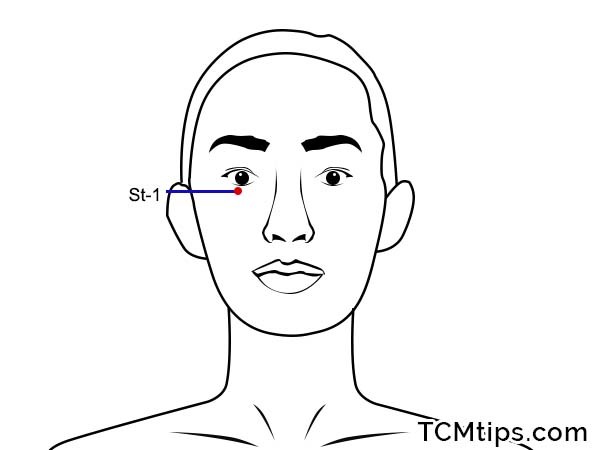
ST-1 is one of the most versatile acupoints around the eyes, effective in treating a wide variety of eye conditions. Stimulating the Cheng Qi (“Tears Container”) clears heat and swelling around the eyes, making this an important acupoint for under-eye inflammation. ST-1 is also one of the primary acupressure points for eye floaters.
Massage the Cheng Qi to reduce swelling and twitching of the eyes, especially that caused by blepharospasm. You can find this acupoint directly below the center of the eye, on top of the infraorbital ridge. Apply gentle pressure with your index finger several times a day, resting between rounds. Take care not to press too hard, as the skin under the eye is especially sensitive.
Acupoint: ST-2 (Other Names: Stomach-2/Si Bai/Four Whites)
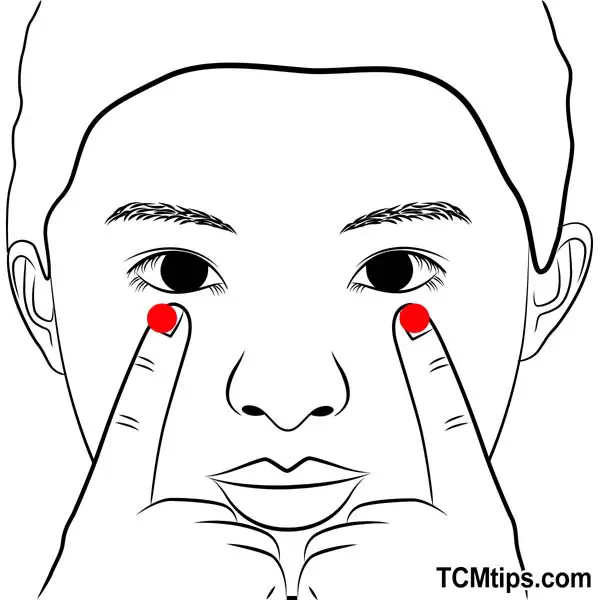
In Chinese medicine theory, the health of the eyes connects to the intestines through the stomach meridian. Acupoints ST-1 and ST-2 function as dispellers of heat from the body and relieve strain and pressure in the eyes, making them effective in acupressure for better vision. Stimulating this point may provide relief from dry eyes by reducing the swelling that inhibits tear formation.
ST-2 is located directly below the eye, just a little lower than ST-1. This acupoint, lying just below the infraorbital ridge, is arguably safer to needle, though it may not be as powerful as ST-1. Massage these two pressure points to stop eye twitching and promote blood flow to the eyes.
Acupoint: GB-1 (Other Names: Gallbladder-1/Tong Zi Liao/Pupil Crevice)
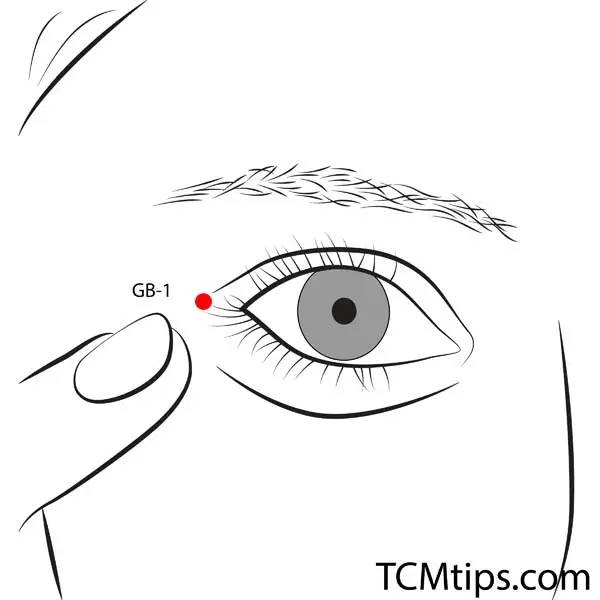
Chinese medicine theory posits a link between the internal organs and the health of the eyes, and this acupoint on the gallbladder channel is believed to be useful in treating eye conditions such as twitching or visual strain. GB-1, known as the “Pupil Crevice,” is regarded as one of the primary acupressure points for dry eyes.
You’ll find GB-1 in the outside corner of the eye sockets. Apply gentle pressure at the point where the facial bones come to a curve. Don’t overdo it—the tissues are soft and sensitive in this area.
Acupoint: EM-5 (Other Names: Tai Yang)
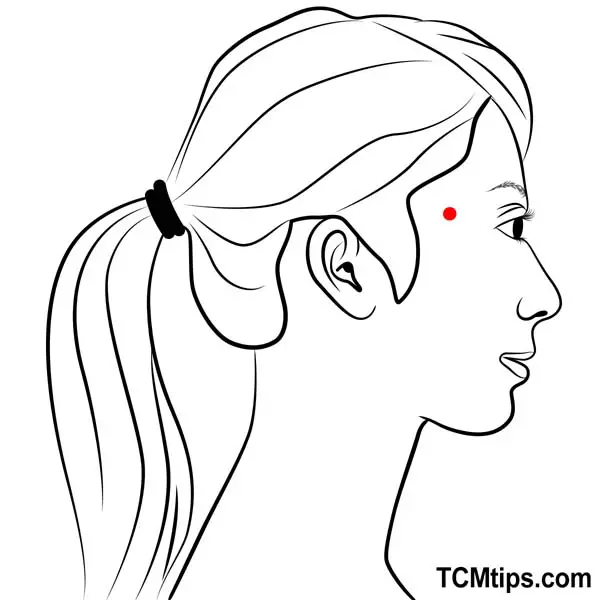
Our next acupressure point for eye twitching is not located on a traditional meridian. EM-5, also known as the Tai Yang, was one of the pressure points to stop eye twitching employed in this promising study from 2013.
Stimulation of EM-5 helps to brighten up the eyes, improve blood circulation, and relieve tension or stiffness in the upper eyelids. Since it has an effect on many different eye conditions, the Tai Yang is regarded as one of the very best acupressure points for the eyes.
EM-5 is located in the depression around one finger-width posterior to the midpoint between the end of the eyebrow and the outer canthus.
Acupoint: LI-4 (Other Names: Large Intestine-4/He Gu/Joining Valley)
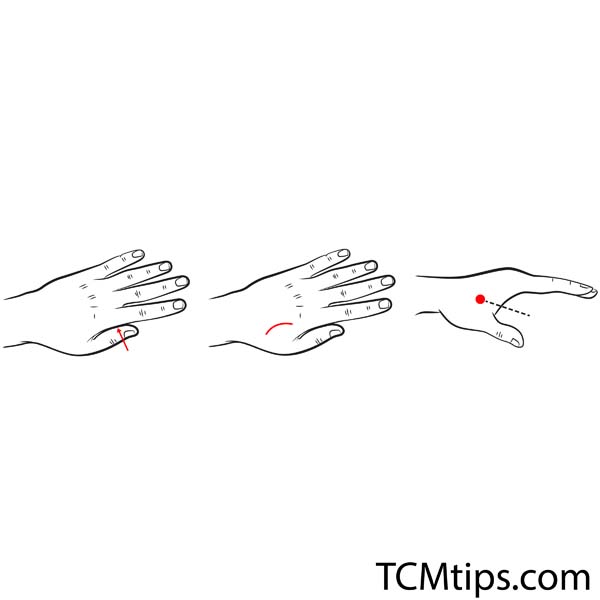
If you consult a Chinese medicine practitioner regarding ocular spasms or blepharospasm, they are sure to recommend needling this point on the liver meridian. In Chinese medicine, the eyes belong to the liver meridian, and conditions of the eyes are related to stress. If you want to practice acupressure for twitching eyes at home, this may be the most important point of all.
LI-4 is effective in treating everything from headaches and toothaches to eye pains, spasms, and facial paralysis. It’s also an important acupressure point for under-eye inflammation.
Known as the He Gu in Chinese, this acupoint is located between the thumb and the index finger, in the muscle that swells there when you make a fist. Stimulating the He Gu helps to calm the autonomic nervous system and reduce stress, which is considered the root cause of eye twitching. Since this point is not located near the eyes, you can apply firm pressure, pressing and kneading the point for 10-30 seconds on each hand.
Acupoint: ST-36 (Other Names: Stomach-36/Zu San Li/Leg Three Miles)
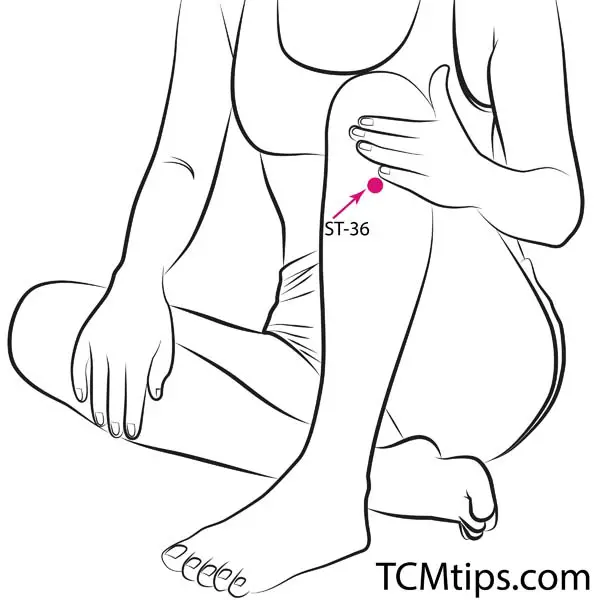
This acupoint on the stomach meridian expels cold and dampness and stimulates the flow of fluids, making it an important point in acupuncture for eye bags.
Zu San Li, as it’s called in Chinese, is also very effective for calming eyelid twitches and spasms. You can find it below the knee, around one finger-width from the tibia’s anterior crest.
This area is less delicate than the points around the eyes, so you can press a little harder. Find a comfortable seated position and apply direct pressure with the thumb for around ten seconds while breathing deeply.
Conclusion
- Massage ST-1 to reduce swelling and twitching of the eyes, especially that caused by blepharospasm.
- Stimulate ST-2 to provide relief from dry eyes and reduce swelling that inhibits tear formation.
- GB-1 is considered a useful acupoint for treating eye conditions such as twitching or visual strain.
- Activating EM-5 improves blood circulation and relieves tension in the eyelids.
- Liver meridian points, such as LI-4, are employed in relieving stress, which is considered the root cause of eye twitching.
- Acupressure at ST-36 expels cold and dampness and prevents the stagnation of fluids.

Try our Anti-Aging Gua Sha Tool designed to bring out your skin’s natural glow.
Best Gua Sha Product- Anti-Aging: The tool is designed to target 11 specific aging signs such as wrinkles and sagging skin. By following the 7-step routine, users can improve skin firmness and reduce fine lines naturally.
- Enhances Skincare Routine: It works effectively with serums and lotions, boosting absorption and efficacy of skincare products.
- Visible Skin Improvement: Users can expect a smoother complexion, reduced puffiness, and a more youthful appearance.
 P. Sze
P. Sze 
















